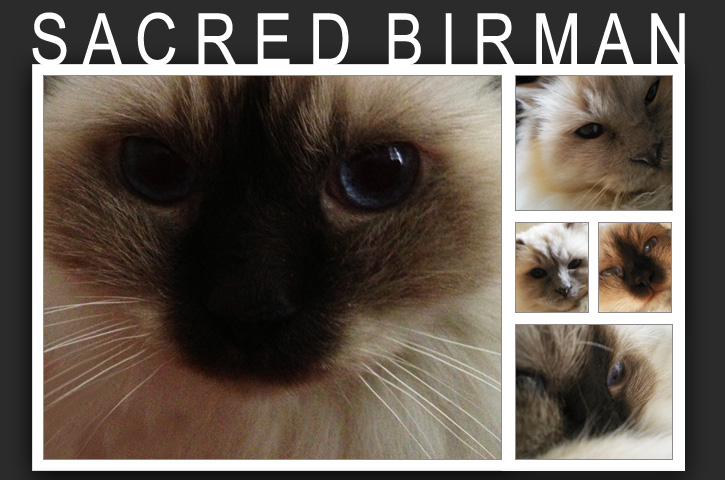 |
 |
| |
A fanlisting is a place for all fans of a particular show, movie,
actor, actress, singer, etc. to come together and build the biggest
listing of people from all around the world who are fans of that subject.
There is no clear record of the origin of Birmans, but one unsourced but oft repeated legend is that the Birman cat originated in Burma where they were kept by temple priests in Northern Burma in the Mount of Lugh. This is repeated as a man received a pair of temple cats from the Temple of Lao-Tsun (The Abode of the Gods ), situated East of Lake Incaougji (Indawgyi Lake), between Magaoung (Mogaung) and Sembo (Shwebo). This legend is attributed to the writings of Mme Marcelle Adam (novelist and president of the Federation Feline Française and owner of Maldapour Birman Cattery) and first published by Dr. François Méry in the French Review Minerva.
There are many colorful stories of how the cats first came to France, including pairs of cats being a reward for helping defend a temple, or being smuggled out of Burma by a Vanderbilt. There is also a story that a couple of stolen birmans (or a pregnant female called Poupée de Maldapour) were imported to France by Thadde Haddisch.
The first traces of historical Birmans go back to a Mme Leotardi in the city of Nice in France.
Birmans were almost wiped out as a breed during World War II. Only two cats were alive in Europe at the end of the war, a pair named Orloff and Xenia de Kaabaa, both belonging to Baudoin-Crevoisier. The foundation of the breed in postwar France were offspring of this pair. They had to be heavily outcrossed with long-hair breeds such as Persian and Siamese to rebuild the Birman breed. By the early 1950s, pure Birman litters were once again being produced. The restored breed was recognized in Britain in 1965 and by the CFA in 1966.
The first Birman cats were seal-point. The Blue-point color was introduced in 1959 using Blue Persian lines. New colors were added by the work of English Breeders in the 1970-1980 including chocolate, red-point, and the tabby/lynx version. A Birman was also used to create new breeds like the Ragdoll cat in California.
Birmans have a medium size rectangular body. Their ears, which are as wide on the base as they are tall, should be set as much on top of the head as on the side and they have a distinct roman nose. The Birman's body color should be color pointed on the extremities with a cast of color across its body corresponding to the point color. Darker point colors usually have a darker cast across the body. The point colors can be seal, blue, chocolate, lilac, red or cream. Tabby and tortie variations are also allowed. Tortie cats can be seal, chocolate, blue or lilac. The same colors exist in Silver/Smoke version while not yet recognize by all clubs. Australian breeders have been recently working on new colors like: Cinnamon point, fawn point. Birmans have an almost round eye shape with the preferred colour being deep sapphire blue.
The Birman's fur should have a silky texture and they are a single coated breed with NO undercoat at all. Unlike a Persian or Himalayan that has a thick short undercoat with long fur on top, the Birman is truly single coated with only one medium-long silky coat. As a result of this coat, Birmans are known to be non-matting which makes them very easy care. Birmans should have no white on their body with the exception of "gloves" on each paw. The white gloving is produced by the white spotting gene and is restricted to the paws only. A spot of white in another area is considered a fault in a Birman cat. Gloves are symmetrical on all four feet. The white must stop at the articulation or at the transition of toes to metacarpals; and all fingers must be white too. The posterior gloves on the back paws finish with an inverted V extended 1/2 to 3/4 up the hock and ideally should be symmetrical.
All Birmans are born white (as other colourpoint kittens are) and they start developing their colours at the age of 1 week if they have a dark colour (as seal-point) and at the age of 14 days, or more, if they have a clear colour (as lilac-point). The first part which develops the colour are the points of ears, nose and tail. The real colour is complete at two years old and after a wintry season.
WikiPedia |
|
|
 |
|
